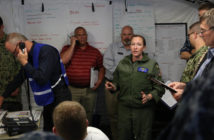In the event of a natural disaster, it is a communications system that could directly impact not only the military but civilian populations on Whidbey Island and across the country.
Members of the U.S. Army’s 51st Expeditionary Signal Battalion from Joint Base Lewis McChord set up camp at Naval Air Station Whidbey Island’s Outlying Field south of Coupeville last week for a training exercise on the Troposcatter communication system.
“The primary effort is to try to exercise our skills and keep them up to date,” said Capt. Frank Guizar.

The system is designed to eliminate the need for satellite signals and line of sight communications. The TROPO system is effective up to 150 miles and will work in virtually any terrain. A signal is bounced up into the troposphere, where it scatters, and then is picked up by another system which has been positioned to best receive that signal. Once the signal is locked in place, communication is easily maintained.
“We’ve tried this system in the desert, in mountainous terrain and we wanted to see how those signals would work over water,” Guizar said.
Whidbey Island is also a key place to test the system because of its location on a major fault. In the event of a major earthquake, for instance, civilian authorities could request assistance from the military and a unit like the 51st could be in place within days.
“We have a seven-day response from the time of notification,” Guizar said. “We can go wherever the need is.”
Once on sight, it takes about an hour to set up the TROPO. It can take a little longer to lock in the signal, as positioning is key. But the system is self-contained and inexpensive to operate, making it a useful tool during both military operations and in natural disasters.
“We have our own power generators and our own repair station,” said Guizar.
“It really costs us nothing once the system is up and running – just fuel,” said Lt. Col. Mike Kaloostian.
While at OLF, Army personnel are communicating with personnel at JBLM – about 82 miles away as the crow flies – sending situational reports on the status of equipment and day to day operations. In the event of a natural disaster, the communications array would be able to provide secure and non-secure voice, data and video communications and allow communication between first responders, government agencies and military personnel.
“We enable communications,” Guizar said.
“We’re trying to make this as realistic as possible,” Kaloostian said. “For example, there are role players at JBLM representing officials from the Federal Emergency Management Agency.”
Sailors from NAS Whidbey’s Maritime Patrol and Reconnaissance Wing 10’s Mobile Tactical Operations Center 12 are also taking part in the training exercise. Wing 10 MTOC uses a similar mobile system.



